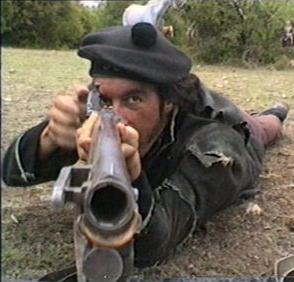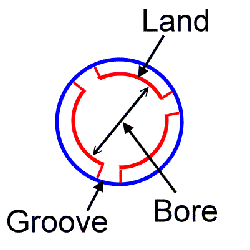
So what was special about the Baker Rifle? Rifles weren't new in 1800, they had been used for hunting for nearly a century, and the huntsmen had taken them to war and intoduced Jägers, Chasseurs and Caçadores to the ranks of the infantry. The American woodsmen had used long rifles to good effect during the War of Independence, and a British officer had invented an effective breech loading mechanism. So why the fuss?
Well, it was the first successful, specifically military rifle. It was simple enough to be mass produced, it was sturdy enough to survive the rigours of campaigning, and it was the weapon designed for a new, elite regiment whose exploits in the Peninsular War made both themselves and their weapon legendary.

The story of the Baker Rifle starts with the Board of Ordnance. In the peculiar set up of the British Army of the Late 18th century the Commander-in-Chief presided over the regiments of the British Army (both Infantry and Cavalry) from his offices in Horse Guards. The weapons which those regiments used were determined by a completely separate department: the Board of Ordnance (which also raised and trained the artillery to be "loaned" to British Commanders in the field when required as well as organising all the weapons for the navy). The Board of Ordnance was a very professional and scientific department, who regularly conducted tests to ensure that the weapons they selected were up to standard. The selection of the Baker Rifle as the weapon of the newly formed Rifle Corps was the end of a process which had lasted two years.
The Board had flirted with rifled weapons 20 years earlier when Patrick Ferguson developed a successful breech-loader and trained a small force of skirmishers during the American War of Independence. With Ferguson's death, the rifle lost it's (then) sole advocate, and the idea fell dormant. In December 1797 parliament authorised the formation of a 5th battalion of the 60th regiment, to be recruited from European (mainly German) exiles familiar with the use of rifled weapons. In 1798 the Board ordered 5,000 rifled muskets from Prussia. It seems likely that the Hompesch Rifles initially used by the 5/60th were part of this batch. The Board were not very happy with the performance of these rifles: they had been designed primarily for hunting, they were excessively slow loading and they required cleaning every few shots. Also the rifles which were delivered were not of the same quality as the samples on which the order had been based. Indeed a significant portion were unusable, and from later reports it would appear that the batch contained rifles of differing bore - a major logistical problem on campaign. The board decided that they had better "do it themselves", particularly as Horse Guards were going ahead with the formation and training of a new, all British Rifle Corps.
In February 1800, as part of a competition for the design of a rifle, the Board conducted a series of tests on a number of rifle barrel designs. The most successful barrel design was that of Ezekiel Baker, a London Gunsmith. While there are no records, it appears that Baker, in consultation with Coote Manningham of the new Rifle Corps, oversaw the development of the rest of the rifle around his barrel. There is no doubt that when the Board wanted to they could move fast. By the end of March a preliminary pattern had been approved, the production chain organised and the first batch of 800 rifles ordered. While there were minor modifications over the years, this original pattern was recognisably the model for all Bakers over the weapon's 40 year life.
Baker's design was not startlingly innovative, rather a refinement of existing practise aimed at military (rather than hunting) requirements. Like most of the longarms of the time, the Baker rifle was a muzzle loading flintlock weapon. The original design had a 32" barrel, with the same bore as the Brown Bess musket (aimed at simplifying logistics). The rifling consisted of seven square cut grooves which completed a mere quarter turn along the length of the barrel. The design was chosen by the Board because:
Changes made to the Baker before it went into service primarily involved reducing the weight of the weapon. Because of the grooves, the average wall thickness of the barrel of a rifle is greater than that of a smooth bore making it significantly heavier. By reducing the length slightly, and reducing the bore to .653" (enabling it to use cavalry carbine shot) the Baker was brought down to the same weight as a Brown Bess (11lb 2oz). This would also reduce the recoil of the weapon resulting in improved accuracy.
There are conflicting figures given for the calibre of both Brown Bess and Baker. Figures of .72" and .705" are given for the Brown Bess musket (which had a nominal bore of .75"). I believe that the larger figure is the inner diameter of the barrel, and the smaller figure the diameter of the shot. Figures of .653" and .615" are given for the Baker (.615" being the calibre of cavalry carbines). By the time of the Peninsular campaign Riflemen were issued with loose shot of .653" diameter for slow but accurate fire (sniping) and cavalry cartridges (with .615" shot) for more rapid "musket" fire.
There are also conflicting descriptions of the rifling of a Baker. The official Baker pattern is 7 rectangular grooves making a quarter turn, but 3-grooved and octagonal barrels are mentioned, as is three-quarter turn. The source of these contradictions lies in the fact that as well as a standard army issue model, Bakers were commissioned for privately raised volunteer forces and these did not have to conform to the army pattern. On the principle that objects which get the least use are those that survive, there are a lot more non-standard militia "Baker"s floating around than genuine army versions.
The image above is of a replica Baker rifle, made by re-enactors in Britain and used by Sean Bean during the filming of the Sharpe series (Image courtesy of Mike). it illustrates the features of the Tower pattern Baker. The barrel is browned for camouflage (the example in the top picture is either a private variant, or has been vandalised by having the browning polished off the barrel). The "furniture" is brass including the distinctive patch box cover on the butt (the later rounded plate style), the swept back pistol grip on the trigger guard and the pipes for the steel ramrod. A few early versions of the weapon had a simple multi-range flip-up back sight, though this was soon abandoned. This replica has the early "swan-neck" cock which proved fragile in the field and was replaced by the tougher ring neck cock (as on the original Baker rifle illustrated below). Not visible in this shot is the raised cheek rest on the left side of the butt and the brass Butt tang which protected the back end of the stock. A short sword, which hooked on to the side of the barrel, served as a bayonet. The side attachment was designed to keep the rifleman's view of his foresight clear. The length of the "sword bayonet" was designed to make the "rifle and sword" the same length as the "musket and bayonet". As a hand to hand weapon it was too short to be effective. Riflemen claimed to have used it primarily for chopping wood, but Rifleman Jackman used his to dig a "foxhole" outside the walls of Flushing from which he sniped at the artillerymen on the walls. Nevertheless riflemen were proud of their "sword" and reacted negatively to suggestions it be replaced with a more standard bayonet.(When a standard bayonet was eventually issued, the riflemen kept their swords!)
 The seven grooves of the official Baker pattern can be clearly seen in the photograph of Michael Mears (a.k.a. Rifleman Francis Cooper) on the right. Also visible is the mounting lug for the sword bayonet (on the left as we look at it) with the catch socket just visible on the top surface just in front of the forward support. A look at the sword bayonet will show that there is a small release button on the hilt to disengage the catch. Below the barrel can be seen the circular end of the ramrod and on top of the barrel is a small raised point which acted as the foresight. The rifle was aimed by aligning this in the notch of the backsight (next to the frizzen). I hesitate to call this a Frenchman's view of the Baker; they weren't supposed to get this close! Thank-you to Jason Salkey for allowing me to use this image from Part 1 of the Video Diaries of Rifleman Harris (available from the Sharpe Appreciation Society).
The seven grooves of the official Baker pattern can be clearly seen in the photograph of Michael Mears (a.k.a. Rifleman Francis Cooper) on the right. Also visible is the mounting lug for the sword bayonet (on the left as we look at it) with the catch socket just visible on the top surface just in front of the forward support. A look at the sword bayonet will show that there is a small release button on the hilt to disengage the catch. Below the barrel can be seen the circular end of the ramrod and on top of the barrel is a small raised point which acted as the foresight. The rifle was aimed by aligning this in the notch of the backsight (next to the frizzen). I hesitate to call this a Frenchman's view of the Baker; they weren't supposed to get this close! Thank-you to Jason Salkey for allowing me to use this image from Part 1 of the Video Diaries of Rifleman Harris (available from the Sharpe Appreciation Society).
The Baker was originally issued to the Experimental Corps of Riflemen in 1800. Light troops of the King's German Legion were issued with it when they formed in 1804. By 1806 the 5/60th were also using it. After the end of the Napoleonic Wars, issue was extended to other Light Regiments. The 21st Royal Scots Fusiliers were a Baker regiment while stationed in Australia from 1833-40.
The Baker Rifle claims the distinction of having the longest service life of any rifle used by the British Army. It was in production from 1800 to 1838, and there are records of issues as late as 1841. It is even mentioned as having been used by troops in the Kaffir Wars of 1851.
(some common terms for the gun illiterate)
 Bore
BorePeter, an active re-enactor sent these procedure descriptions.
Loading the Baker Rifle for sharpshooting.
Loading the Baker Rifle or Musket for rapid fire.
Notes on firing a flintlock musket or rifle.
Another article on the Baker Rifle from the book "Arming the Rifleman".
All junior officers were issued with a Baker and did basic training in line infantry tactics and sharpshooting when they joined the Rifles. Most did not carry their rifles on active service, but it was not unknown. Lieutenant Strode, a noted marksman killed at Casal Nova, always carried his rifle.
Go to The Baker Rifle from the book "Arming the Rifleman"
Go to The Flintlock
Return to Random Shots
Return to Main Page
Content Copyright © 2000, 2001, 2002, 2003 Susan H Law and her licensors. All rights reserved.
Last update 11/3/03